Related Research Articles

Federal Hall is a historic building at 26 Wall Street in the Financial District of Manhattan in New York City. The current Greek Revival–style building, completed in 1842 as the Custom House, is owned by the United States federal government and operated by the National Park Service as a national memorial called the Federal Hall National Memorial. The memorial is named after a Federal style building on the same site, completed in 1703 as City Hall, which the government of the newly independent United States used during the 1780s.

Castle Clinton is a restored circular sandstone fort within Battery Park at the southern end of Manhattan in New York City. Built from 1808 to 1811, it was the first American immigration station, predating Ellis Island. More than 7.5 million people arrived in the United States at Fort Clinton between 1855 and 1890. Over its active life, it has also functioned as a beer garden, exhibition hall, theater, and public aquarium. The structure is a New York City designated landmark and a United States national monument, and it is listed on the National Register of Historic Places.

Raymond Hezekiah Torrey was the author of weekly columns, Outings and The Long Brown Path in the New York Evening Post in the 1920s and 1930s. The column played a major role in the development of the 2,100-mile (3,400 km) Appalachian Trail, the Long Path and the popularity of hiking generally. He was a founding member of the New York–New Jersey Trail Conference and one of the authors of the first edition of the New York Walk Book. He had extensive scientific knowledge, writing about everything from the short-billed marsh wren to marine fossils and lichens; he could identify over 700 plants. He was secretary of the Association for the Preservation of the Adirondacks, and also secretary of the American Scenic and Historic Preservation Society.

Hamilton Grange National Memorial is a historic house museum within St. Nicholas Park in the Hamilton Heights neighborhood of Manhattan in New York City. Operated by the National Park Service (NPS), the structure was the only home ever owned by U.S. Founding Father Alexander Hamilton. The house contains exhibits for visitors, as well as various rooms with restored 19th-century interiors. Originally located near present-day 143rd Street, the house was moved in 1889 to 287 Convent Avenue before being relocated again in 2008 to St. Nicholas Park. The structure is a New York City designated landmark and a United States national memorial, and it is listed on the National Register of Historic Places.

Stony Point Battlefield is a historic site in Rockland County, New York; the location of the 1779 Battle of Stony Point during the American Revolutionary War. It is a National Historic Landmark and has a museum.
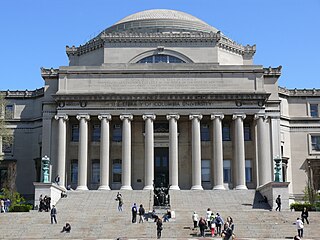
The Low Memorial Library is a building at the center of Columbia University's Morningside Heights campus in Upper Manhattan, New York City, New York, United States. The building, located near 116th Street between Broadway and Amsterdam Avenue, was designed by Charles Follen McKim of the firm McKim, Mead & White. The building was constructed between 1895 and 1897 as the university's central library, although it has contained the university's central administrative offices since 1934. Columbia University president Seth Low funded the building with $1 million and named the edifice in memory of his father, Abiel Abbot Low. Low's facade and interior are New York City designated landmarks, and the building is also designated as a National Historic Landmark.

The Pugsley Medal was created by Cornelius Amory Pugsley in 1928. The award honors champions of parks and conservation.
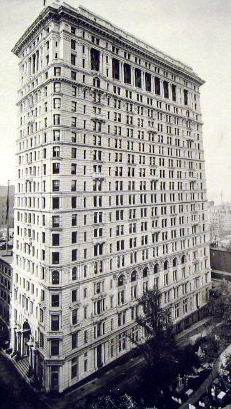
The Empire Building is an office building and early skyscraper at 71 Broadway, on the corner of Rector Street, in the Financial District of Manhattan in New York City. It was designed by Kimball & Thompson in the Classical Revival style and built by Marc Eidlitz & Son from 1897 to 1898. The building consists of 21 stories above a full basement story facing Trinity Place at the back of the building and is 293 feet (89 m) tall. The Empire Building is a New York City designated landmark and is listed on the National Register of Historic Places (NRHP). It is also a contributing property to the Wall Street Historic District, a NRHP district created in 2007.

Prairie Avenue is a north–south street on the South Side of Chicago, which historically extended from 16th Street in the Near South Side to the city's southern limits and beyond. The street has a rich history from its origins as a major trail for horseback riders and carriages. During the last three decades of the 19th century, a six-block section of the street served as the residence of many of Chicago's elite families and an additional four-block section was also known for grand homes. The upper six-block section includes part of the historic Prairie Avenue District, which was declared a Chicago Landmark and added to the National Register of Historic Places.
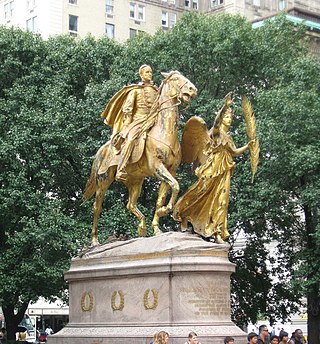
Grand Army Plaza is a square at the southeast corner of Central Park in Manhattan, New York City, at the intersection of Fifth Avenue and Central Park South, covering two blocks on the west side of Fifth Avenue between 58th and 60th Streets. It contains an equestrian statue of William Tecumseh Sherman on its northern half and the Pulitzer Fountain on its southern half.

The Gould Memorial Library is a building on the campus of the Bronx Community College (BCC), an institution of the City University of New York (CUNY), in University Heights, Bronx, New York City, United States. The building was designed by Stanford White of the firm McKim, Mead & White. Constructed between 1895 and 1900 as the central library of New York University (NYU)'s Bronx campus, it was part of the New York University Libraries system. The library is named after railroad magnate Jay Gould, whose daughter Helen Miller Shepard funded the project in his memory. Gould is no longer used as a library, instead serving primarily as an event space. Gould's facade and interior are New York City designated landmarks, and it is also listed on the National Register of Historic Places.
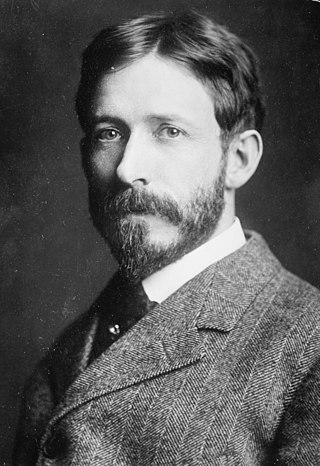
George McAneny, was an American newspaperman, municipal reformer and advocate of preservation and city planning from New York City. He served as Manhattan Borough President from 1910 to 1913, President of the New York City Board of Aldermen from 1914 to 1916, and New York City Comptroller in 1933. He also held several other positions throughout his career, serving as an executive officer of the New York City Civil Service Commission in 1902, secretary of the New York Civil Service Reform League (1894-1902), executive manager of The New York Times (1916-1921), and president of the Regional Plan Association (1930-1940).

Barbaralee Diamonstein-Spielvogel is an American preservationist, historian, author, and television producer. She is an advocate for the preservation of the historic built environment and the arts. She has worked in the fields of art, architecture, crafts, historic preservation, fashion, and public policy in the U.S. She is the author of 24 books, numerous articles and essays, and recipient of many honors and awards. She is a former White House Assistant, the first Director of Cultural Affairs in New York City, and the longest serving New York City Landmarks Preservation Commissioner.
Alexander Morgan Hamilton was an American philanthropist and civil servant. He was the grandson of J. P. Morgan the financier, and great-great-grandson of Alexander Hamilton, the first Secretary of the Treasury of the United States.

488 Madison Avenue, also known as the Look Building, is a 25-story office building in the Midtown Manhattan neighborhood of New York City. It is along Madison Avenue's western sidewalk between 51st and 52nd Streets, near St. Patrick's Cathedral. 488 Madison Avenue was designed by Emery Roth & Sons in the International Style, and it was constructed and developed by Uris Brothers. The building was originally named for its primary tenant, the American magazine Look.
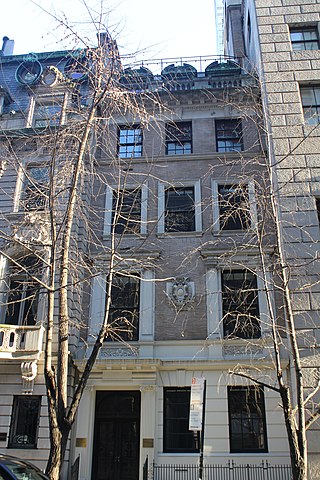
5 West 54th Street is a commercial building in the Midtown Manhattan neighborhood of New York City. It is along 54th Street's northern sidewalk between Fifth Avenue and Sixth Avenue. The four-story building was designed by R. H. Robertson in the Italian Renaissance Revival style and was constructed between 1897 and 1899 as a private residence. It is the easternmost of five consecutive townhouses erected along the same city block during the 1890s, the others being 7, 11, 13 and 15 West 54th Street. The first floor is clad with rusticated blocks of limestone, while the other floors contain buff-colored brick trimmed with limestone.

The Engineers' Club Building, also known as Bryant Park Place, is a residential building at 32 West 40th Street in the Midtown Manhattan neighborhood of New York City, United States. Located on the southern edge of Bryant Park, it was constructed in 1907 along with the adjoining Engineering Societies' Building. It served as the clubhouse of the Engineers' Club, a social organization formed in 1888. The building was designed by Henry D. Whitfield and Beverly S. King, of the firm Whitfield & King, in the neo-Renaissance style.
References
- ↑ "Scenic and Historic America: Bulletin of the American Scenic and Historic Preservation Society." ASHPS 2.1 (March 1930):3.
- ↑ NYPL Archives - Collection Overview
- ↑ "Fort Brewerton will be restored by Historic Society". New York Times. No. p. 11. November 23, 1927.
- ↑ "Hamilton Grange becomes memorial". New York Times. No. p. 12, column 1. November 18, 1924.
- ↑ Annual Report of the ASHPS from the Hathi Trust
- ↑ "For Washington Site Presented to Historic Society". New York Herald Tribune. No. p. 9. July 4, 1926.
- ↑ "3 to get medals of scenic society". New York Times. No. section II, page 1, column 3. Oct 28, 1934.
- ↑ "Moses to get prize from scenic societyy". New York Times. No. page 23, column 4. January 26, 1937.
- ↑ "Dr. Kimball Announces Pugsley Medal Awards". New York Herald Tribune. No. p. 21. January 16, 1940.
- ↑ "McAneny Heads Scenic Society". New York Times. No. p.9. October 20, 1942.
- ↑ "McAneny Heads Scenic Society". New York Times. No. p.9. October 20, 1942.
- ↑ "George M'Aneny at 80". New York Times. No. p. 14. December 24, 1949.
- ↑ "Saved for Posterity: Historic Buildings at St. John's Saved from the Navy". New York Herald Tribune. No. p. 12. July 12, 1946.
- ↑ "Udall gets medal for conservation". New York Times. No. p. 52, column 6. February 6, 1965.
- ↑ "U.S. Grant 3d wins history unit medal". New York Times. No. p. 20. November 21, 1951.